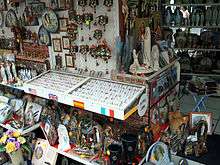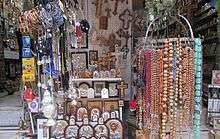Devotional articles



Devotional objects (also, devotional articles, devotional souvenirs, devotional artifacts) are religious souvenirs (figurines, pictures, votive candles, books, amulets, and others), owned and carried by the faithful, who see them as imbued with spiritual values, and use them for votive offering.[1][2] Production and sales of devotional articles have become a widespread industry in the vicinity of various religious sites all over the world.[1][3]
Devotional articles have a long history; in Christianity they have been mentioned in historical works such as those related to Paul the Apostle[4] and in older religions they have been traced as far back as the times of ancient Egypt and ancient Mesopotamia.[2] International law defines "devotional articles" as including but not limited to "the Bible, the Koran, prayer and service books, hymnals, ritual articles, sacramental wine, crucifixes and rosaries".[5] Such items may be natural and hardly processed (such as earth from the Holy Land), but majority of modern devotional articles are mass-produced (strips of paper with prayers, pictures of holy figures, prayer books, etc.).[1] Such items are usually seen as having little artistic value, as their primary function is not decorative but spiritual.[1][2]
American sociologist Charles H. Lippy observed that such articles are "means of access to the supernatural", and are criticized by some as superstition.[6] Devotional articles owned by famous religious figures, such as Catholic Saints, commonly become religious relics.[7] Widespread popularity of certain devotional articles has, throughout centuries, influenced the public popular image of certain religious symbols, such as angels.[8] In other cases, devotional objects might have mixed symbols of different religion, for example popularizing and entrenching pagan elements in Christianity, resulting in objects such images of Black Madonna.[2]
See also
- Holy card
- Monza ampullae
- Pilgrim badge
- Prayer beads
- Prayer wheels
- Religious art
- Religious goods store
- Religious tourism
References
- 1 2 3 4 Fondazione "Giorgio Cini." (1961). Encyclopedia of World Art: Cossa to Eschatology. McGraw-Hill. p. ccxi.
- 1 2 3 4 Colum Hourihane (6 December 2012). The Grove Encyclopedia of Medieval Art and Architecture. Oxford University Press. pp. 285–287. ISBN 978-0-19-539536-5.
- ↑ Chris Park (1 November 2002). Sacred Worlds: An Introduction to Geography and Religion. Routledge. p. 192. ISBN 978-1-134-87734-8.
- ↑ Eckhard J. Schnabel (28 January 2010). Paul the Missionary: Realities, Strategies and Methods. InterVarsity Press. p. 111. ISBN 978-0-8308-7900-7.
- ↑ Dieter Fleck; Michael Bothe (January 2008). The Handbook of International Humanitarian Law. Oxford University Press. p. 431. ISBN 978-0-19-923250-5.
- ↑ Charles H. Lippy (1 January 1994). Being Religious, American Style: A History of Popular Religiosity in the United States. Greenwood Publishing Group. p. 89. ISBN 978-0-313-27895-2.
- ↑ Stephen Sharot (2001). A Comparative Sociology of World Religions: Virtuosos, Priests, and Popular Religion. NYU Press. p. 189. ISBN 978-0-8147-9805-8.
- ↑ Peter Marshall; Alexandra Walsham (31 August 2006). Angels in the Early Modern World. Cambridge University Press. p. 24. ISBN 978-0-521-84332-4.
| Wikimedia Commons has media related to Devotional souvenirs. |